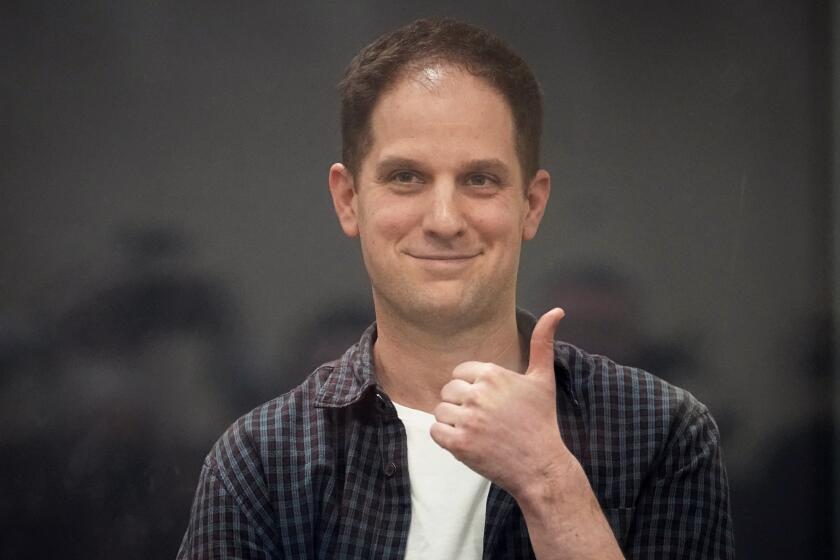Access to Job Market in U.S. a Matter of Degrees
This spring, a U.S. high-tech company recruited British citizen Gareth Lloyd for a possible engineering job.
But before the Irvine office made its hiring decision, the number of available visas for skilled workers ran out, in a record time of less than two months.
Lloyd, who has degrees in applied physics and electrical and electronics engineering, found another job in Germany.
“I was a little bit incredulous,” Lloyd, 34, said in a phone interview. “It seems arbitrary to put some kind of quota on this.”
Much of the national debate on immigration has centered on undocumented workers who fill agriculture, construction and service jobs. But highly skilled foreign scientists, engineers and computer programmers recruited by U.S. companies to work here legally also have a lot at stake in the outcome. “The major focus for all the laws and all the bills has mainly been for illegal immigrants,” said Swati Srivastava, an Indian software engineer who lives in Playa del Rey and is waiting for her green card. “We kind of get pushed to the sidelines.”
The Senate’s sweeping immigration bill that passed in May calls for increasing the number of H-1B visas, which are available for professional foreign workers, from 65,000 to 115,000 annually. Foreigners with certain advanced degrees would be exempt from the cap.
Despite President Bush’s urging to increase such quotas, however, the House bill that passed late last year does not include any provisions for skilled-worker visas. And a conference committee, which would negotiate a compromise, has yet to be selected. U.S. companies complain that they are losing prospective employees to other countries because of a shortage of highly skilled and educated foreign workers. As a result, companies are either outsourcing science and engineering jobs or making do with fewer employees.
“There aren’t enough U.S. citizens pursuing those types of degrees,” said Jennifer Greeson, spokeswoman for Intel Corp. in Santa Clara, Calif., where about 5% of the company’s U.S.-based employees are on H-1B visas. “U.S. companies being able to have access to talent, no matter where it originates, is key to our continued competitiveness.”
But critics of the H-1B program argue that there are enough Americans qualified for the jobs. Companies just prefer to hire younger, less expensive workers from other countries, such as India and China, instead of more experienced American workers at higher salaries.
“The bottom line is cheap labor,” said UC Davis computer-science professor Norman Matloff, who has studied the H-1B program.
The six-year visas are available to foreigners with at least a bachelor’s degree. Firms must pay foreign workers the prevailing wage.
The U.S. Citizenship and Immigration Services agency begins accepting H-1B visa applications on April 1 each year. The agency received enough visas to hit the congressionally mandated cap of 65,000 at the end of May this year, compared with August in 2005 and October in 2004. Those who receive the visas can begin work Oct. 1, the start of the fiscal year.
There are also 20,000 additional visas available for foreign workers who earned a master’s or higher-level degree in the U.S. The Citizenship and Immigration Services is still accepting applications for those visas.
Because the H-1B cap is reached more quickly each year, many companies prepare their paperwork ahead of time so they can be at the front of the line. But they say it’s often difficult to make hiring decisions six months before the start date.
Orange County immigration attorney Mitchell Wexler has a courier ready on the first day to take his clients’ completed applications to Citizenship and Immigration Services.
“The whole white-collar business community is kind of crossing our fingers” that the number of visas is raised, Wexler said. Highly skilled foreign workers, he said, are “the best and brightest” and should be invited into the economy.
“If we can’t get them,” Wexler added, “they will go to a country that will accept them, and they will get jobs in Canada, Australia and England and will compete against us.”
One of Wexler’s clients, Massachusetts-based Skyworks Solutions, develops and manufactures integrated circuits for cellphones. Connie Williams, senior human resources specialist at the company’s Irvine office, said her firm was effectively cut off from a foreign labor pool that included Lloyd of Britain when the government stopped accepting H-1B applications.
Williams said she worries that if Congress fails to pass reform legislation, the door will slam shut even earlier next year. The company has just over 2,000 U.S.-based employees, roughly 100 of whom have H-1B visas.
“We need these highly skilled, highly educated, highly qualified engineers,” said Williams. “These people are a needle in a haystack.”
Once foreigners have H-1B visas, they face another hurdle -- becoming permanent legal residents. Applicants are often forced to wait years because there are only 140,000 employment-based green cards available annually. A backlog at Citizenship and Immigration Services adds to the delays.
Swati and Aradhana Srivastava, 34, both Indian software engineers working in the U.S. on H-1B visas, began the green card process with their employer in November 2001. Since then, the sisters said they have not been able to change jobs, positions or salaries.
They have taken film classes and are eager to pursue second careers in filmmaking but cannot do so until after they get their green cards. They also are reluctant to buy property or start a business. If they don’t get their green cards by the time they finish film school, the sisters may return home.
“It’s like living in a holding pattern continuously,” said Swati Srivastava, 28, a member of Immigration Voice, a new grass-roots organization of skilled foreign workers pushing for immigration reform. The Internet-based group formed late last year and has about 5,000 members scattered around the country.
“We work in [the] U.S. legally in high-skilled jobs, but we still get penalized for playing by the rules,” Immigration Voice co-founder Aman Kapoor said in an e-mail. “Since no one was working on our issues, we decided to organize.”
Sandy Boyd, vice president of the National Assn. of Manufacturers, said there is an urgency to fixing the problems facing highly skilled foreign workers, whether they’re seeking temporary or permanent legal status. The Senate’s proposed immigration bill would increase the number of available employment-based green cards.
If compromise legislation cannot be reached on the broader issues, Boyd said, Congress should pass a separate, more narrow reform bill.
“This is not an issue that can be put off until comprehensive immigration reform is passed,” Boyd said, “because once we lose these jobs, it’s very difficult for them to come back.”
But industry lobbyists arguing against increases in H-1B visas say the program hurts U.S. citizens by lowering wages and increasing job competition. They cite a recent report by the Government Accountability Office that says the program lacks sufficient oversight from the Department of Labor.
“We feel for the most part there are not shortages of U.S. engineers and computer scientists that have the skills these companies are looking for,” said Chris McManes, spokesman for the U.S. sector of the Institute of Electrical and Electronics Engineers. “If the cap is increased, that will further hamper the ability of a U.S. engineer to find a job.”
David Huber, a network engineer in Chicago and U.S. citizen by birth, said he twice lost out on jobs to foreign workers. He was passed over for one job and replaced at another, he said. Huber, who testified before the House in March, said he could not find work for nearly three years, despite his education and experience. “Too many of us cannot find jobs because companies are turning to H-1B workers as a first choice,” Huber said in written testimony to the House.
Swadha Sharma, who lives in Arcadia, said she is not trying to replace U.S. workers. Sharma earned an electronics engineering degree in India but has long dreamed of becoming a math teacher. So while her husband worked here on an H-1B visa, she earned her teaching credential at Cal Poly Pomona.
Sharma, 30, started applying for teaching jobs early this year, but she said only one of three interested districts was willing to sponsor her for an H-1B visa. And that offer, from a Los Angeles charter school, came after the visa cap had been reached. Sharma now plans to pursue a master’s degree but said the U.S. is “missing out on a catch.”
“I am really qualified,” she said. “Hopefully, I will be able to teach soon.”
As for Lloyd, his plans to come to the United States are now on indefinite hold. He started his job in Germany but still laments the U.S. immigration system for limiting workers like himself from coming here.
“The H-1B scheme seems a little bit ridiculous,” he said. “I would certainly be an asset to the American economy.”
More to Read
Start your day right
Sign up for Essential California for news, features and recommendations from the L.A. Times and beyond in your inbox six days a week.
You may occasionally receive promotional content from the Los Angeles Times.






